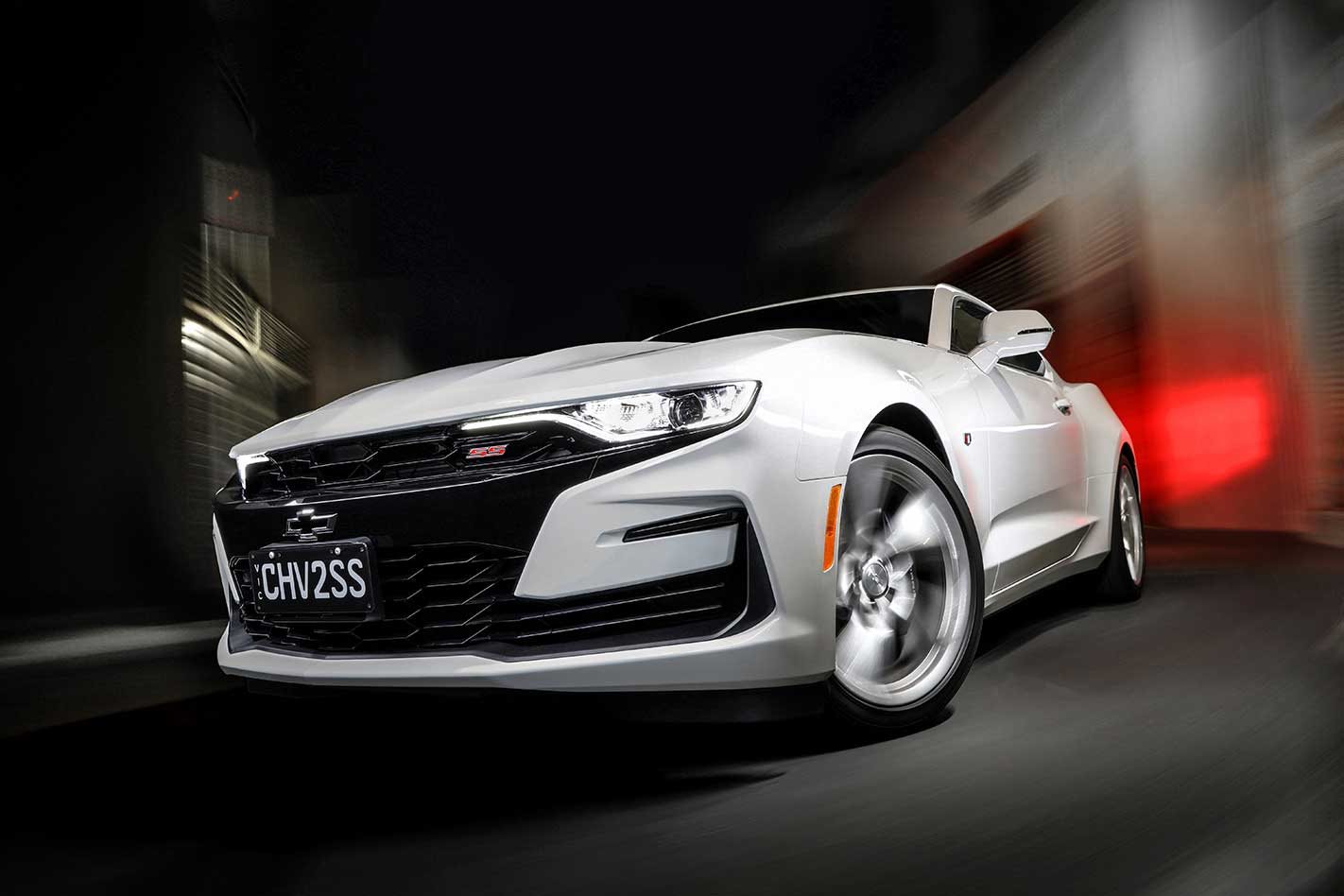Smoke slowly rises through the 2019 Chevrolet Camaro 2SS’s cabin. Along with a smell. It’s acrid, oily but, thankfully, of the Goodyear Eagle F1 kind. We’ve just laid our first Line-Lock assisted burnout and the dense white cloud in our rear mirrors confirms, yep, it was a good one.
New for the 2019 model year, the technology automates burnouts. You’ll find it buried somewhere in the new, higher-resolution screen menu huddled between the analogue instruments. And when you do, it’ll tell you how much pressure to squeeze through the brakes and when.

It then locks the front calipers as you bury the throttle. Next, with the rear axle spinning at 5000rpm in fifth, it’ll automatically walk the car forward at snail’s pace, laying down gluey strips of rubber that you’ll trace later for a launch. Nice. Cool as it is, though, it’s only a party trick reaped through a much more crucial change.
Chevrolet armed its V8 invader with a new 10-speed transmission for its mid-cycle update. Co-developed with Ford, it’s closely related to the Mustang GT’s vaunted 10-speed ’box. GM first bolted it into the circuit-swallowing ZL1 in 2016 and then adapted it for the 2SS. The only difference is the ZL1 gets the 10L90 series, whereas this uses the 10L80.
Although ‘80’ means it’s rated for less grunt, it still employs state-of-the-art construction. Contained in an aluminium case it weighs a mite more than the old eight-speed automatic and spans a smidge longer, as well. It fits right in its place, even with all the extra technology crammed inside.
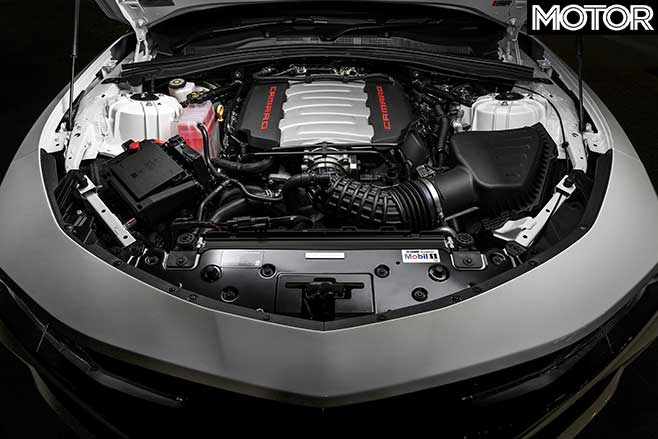
Ultra-thin fluids, new clutches, and integrated solenoid valves give GM the confidence to compare it with Porsche’s PDK dual-clutch gearbox on shift times. But do extra ratios really sharpen the SS’s sting when its 339kW and 617Nm remain unchanged? The drag strip will tell.
Pre-flight checks are as follows. Disable ESP. Leave the transmission in Drive. Hold the brake, gently, and tickle the throttle. About 1800rpm does it. Softly, but quickly, release the brake. Then blend the throttle in as a new, lighter, thinner torque converter locks-up. Feel the weight shift back, sink the gas.
The exhaust bellows through the cabin as you charge forward. It also pops violently on each shift as transmission oil flows through shorter passages, into better designed clutches, to grab the next gear quicker. Meanwhile, the torque converter stays locked, for maximum power transfer.
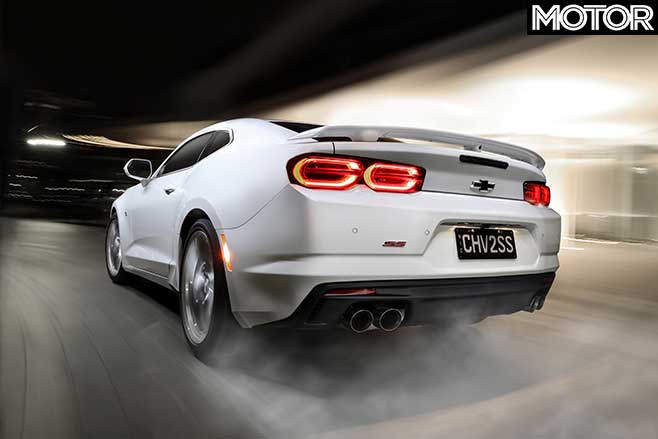
Chevrolet claims the new Camaro is no faster than the MY18 eight-speed automatic version, but in a straight line race with that car’s best recorded figures, it’s already hit 100km/h from rest 0.09sec earlier. And that’s just the start of it.
While the MY18 crosses the line on its limiter in third, the newer 2SS, in fifth, arrives 0.23sec earlier with a 12.57sec pass at 185.13km/h. That’s 3.4km/h faster, even though it had to complete two more shifts. The lesson? Clever gearing can extract more from an engine without adding power.
As it turns out, the first two gears in the MY19 car are exactly the same as the MY18. But for good reason. The LT1’s sizeable torque peak lies at 4600rpm. So second gear drops revs just under that, helping accelerate the car’s sizeable mass off the line. Then once it’s built some momentum and crucial wheel speed, the ratios tighten back up.
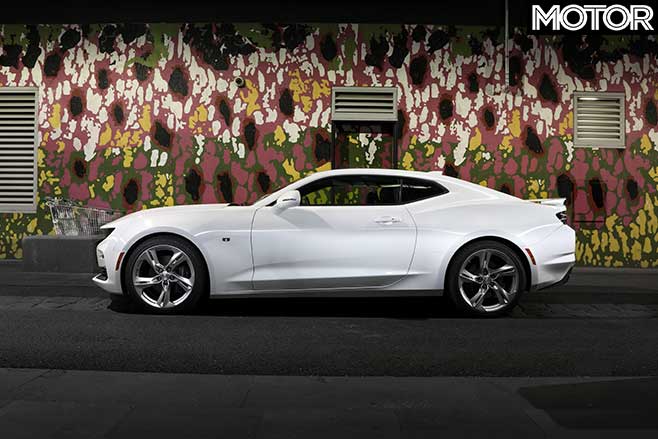
In fourth, fifth and sixth gear the revs land closer to its 5700rpm power peak until you’re into seventh, at 242km/h. Revs fall back to half way between the power and torque peaks, at 5070rpm, so it can cleave through mounting wind resistance. And not just in a straight line. We’d imagine this advantage plays out several times on a racetrack.
The gear paddles still sound awful when you pluck one, but they also control a much meaner-sounding LT1. Swapping the Camaro’s transmission let engineers devise new engine and bi-modal exhaust software. For instance, upshifts under 3000rpm are fairly uneventful.
Squeeze the pedal a little harder, though, to spike the revs into the mid-range, and it’ll crackle on overrun like it’s gurgling nitro. Or nail the gas, pluck a gear above 5000rpm and it’ll fire crack from the exhaust, just like we heard at the dragstrip. But there are times it’s not always this raucous.
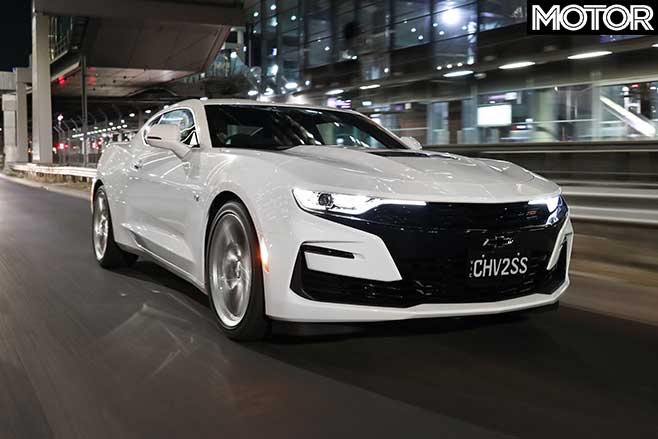
Left to its own devices the transmission rushes through gears to tame the V8’s thirst. Even in Track mode. Then once revs drop on a steady throttle, it shuts off a cylinder bank, resulting in an uninspiring ticking sound from the engine bay.
The cure? Stay in the transmission’s manual mode. Chevrolet also spruiks its ‘Lift-Foot Gear Hold’ technology that supposedly better holds gears through corners off throttle. But that’s what a good automatic should do.
When you stomp the gas it’ll quickly wake. At 110km/h in ninth at 1590rpm, the ’box downshifts multiple gears in what feels like an instant, vanquishing dawdling caravans with ease. Sure, it doesn’t work with the visceral crispness of the Mustang’s 10-speed automatic, but it knows exactly where to land in the engine’s torque-laden rev-range.
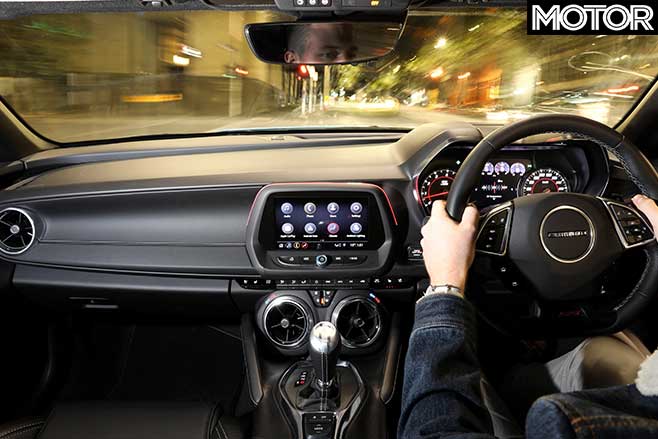
Chevrolet’s left the suspension package alone, carrying over 245/40 (front) and 275/35 (rear) Goodyear Eagle F1 Asymmetric 3 run flats on 20-inch wheels. They still find a very firm ride underneath GM’s FE3-spec suspension on Aussie roads and tip the ride-and-handling balance into the realms of compromised sports cars. Until, that is, magnetic dampers arrive. That’s okay, though, as it’s still the most agile muscle car even if its iffy steering weight spoils the front-end’s feedback.
Sight an apex, commit and there’s varying levels of resistance as you turn the wheel. The ZL1 will reveal almost all the Alpha platform’s potential when it lands, but the 2SS’s sweet driving position and tactile chassis transmit a lot about grip levels. Exceed its limit and the stability system nips any slip, feeling only a touch more intrusive than HSV’s Competition ESC.
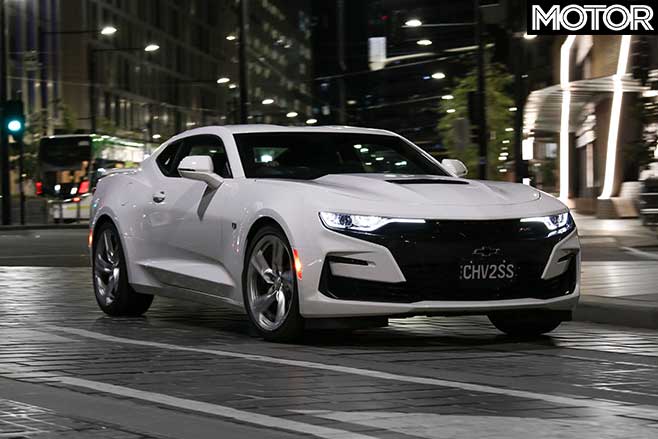
You won’t need to hold big, dirty third-gear drifts to catch anyone’s attention, its striking new front-end, defined by a vented bonnet and ‘Flowtie’ grille (the Chevy badge on the front is hollow, letting extra air through to the radiator), spins heads wherever it goes.
With those ‘dual element’ LED headlights peering out from a huge gaping maw, the fresh face is joined by rear lights that glow with a new design, swapping the old rectangular-shaped units for a pair of hot-plate ovals. Enjoy it while you can, though.
Backlash to its styling has been so strong in America, Chevrolet has decided to restore its bow tie badge to the grille for 2020, choosing style over cooling. It’s not clear when HSV will switch to the new design; it’s focused on simply converting Camaros to right-hand drive well enough to impress GM. That’s why, after only months since it injected the first ones into Holden dealers, it’s earned access to the 2019 version and a much-needed change to the local build process.
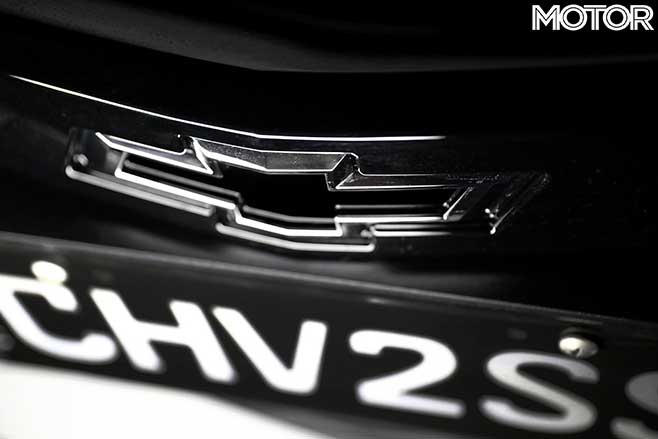
Clayton still plays middle-man. In that, it still imports core vehicles and then re-manufacturing them, but it now receives American spec cars instead of Argentinian ones, gaining more control over what’s included for the slightly inflated price.
That sunroof disappears from the standard equipment list and is replaced by a heads-up display HSV figured how to swap to the right side. On top of that, a forward-collision and rear cross-traffic alert system are included. Oh, and there’s a reversing camera mirror to boost over-shoulder visibility.
At $89,190 the automatic’s price rises $3200. Meanwhile, a six-speed manual version, that should be on sale by the time you read this, starts the range at $86,990. A drive, and verdict, on what transmission partners better with the LT1 V8 will come. Either way, we can confirm you’re getting HSV’s best effort for build quality and finish.

Admittedly, the steering column developed a squeak from a faulty seal. But that’s it. Everything inside feels tighter and the materials ooze a semi-premium vibe. Those cylindrical indicator stalks are a literal touch of VF Commodore, too.
Despite some inherent design quirks – like that tilted centre screen – the HUD and crisper LCD graphics for its Infotainment 3 system boost the cabin technology, and it’s a step forward. And that’s the best way to sum up the 2019 Camaro.
At an OEM-level Chevrolet needs to silence the Camaro’s dull sounding paddles, inject more aggro into the powertrain’s Track mode and smooth its ride (or HSV needs to offer optional magnetic dampers). But the mechanical upgrades, combined with HSV’s advances in manufacturing, equal a big improvement over the MY18 for just an extra $3200.
So, it’s faster, more usable, more responsive and can rip a mighty burnout with ease. And after the smoke clears, this Camaro’s guaranteed to be exclusive when GM reverts back to the old face. All it needs now to prove itself is a rematch with the Ford’s legendary Pony. Giddy up.
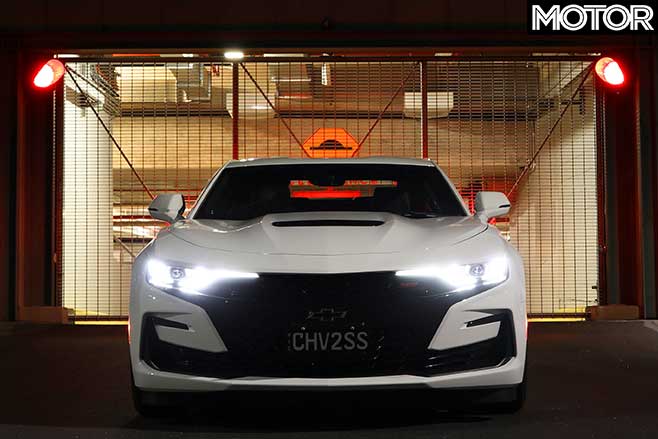
FAST FACTS 2019 Chevrolet Camaro 2SS BODY: 2-door, 4-seat coupe DRIVE: rear-wheel ENGINE: 6162cc V8, OHV, 16v BORE/STROKE: 103.25 x 92.0mm COMPRESSION: 11.5:1 POWER: 339kW @ 5700rpm TORQUE: 617Nm @ 4600rpm WEIGHT: 1710kg POWER-TO- WEIGHT: 198kW/tonne TRANSMISSION: 10-speed automatic SUSPENSION: struts, dampers, coil springs, anti-roll bars (f); multi-links, dampers, coil springs, anti-roll bars (r) L/W/h: 4784/1897/1348mm WHEELBASE: 2811mm TRACKS: 1600/1597mm (f/r) STEERING: electrically assisted rack-and-pinion BRAKES: 345mm ventilated discs, 4-piston calipers (f); 339mm ventilated discs, 4-piston calipers (r) WHEELS: 20.0 x 8.5-inch (f); 20.0 x 9.5-inch (r) TYRES: Goodyear Eagle F1 Asymmetric 3, 245/40 ZR20 95Y (f); 275/35 ZR20 98Y (r) PRICE: $89,190
PROS: Crackly overrun; responsive shifts; more interior tech CONS: Stiff ride; frugal-focused drivetrain; price increase RATING: 4 out of 5 stars
The Strip
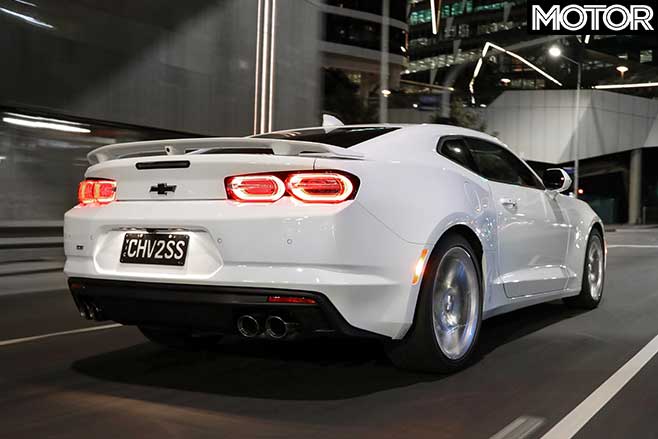
| Chevrolet Camaro 2SS | |
| 0-10km/h | 0.35sec |
| 0-20km/h | 0.71sec |
| 0-30km/h | 1.07sec |
| 0-40km/h | 1.48sec |
| 0-50km/h | 1.88sec |
| 0-60km/h | 2.36sec |
| 0-70km/h | 2.87sec |
| 0-80km/h | 3.38sec |
| 0-90km/h | 3.95sec |
| 0-100km/h | 4.59sec |
| 0-110km/h | 5.23sec |
| 0-120km/h | 5.95sec |
| 0-130km/h | 6.69sec |
| 0-140km/h | 7.58sec |
| 0-150km/h | 8.46sec |
| 0-160km/h | 9.46sec |
| 0-170km/h | 10.61sec |
| 0-180km/h | 11.86sec |
| 0-400m | 12.57sec @ 185.13km/h |
| 80-120km/h (Drive) | 2.53sec |
| 100-0km/h | 33.78m |
| Speed in gears | |
| 1st | 66km/h @ 6500rpm |
| 2nd | 104km/h @ 6500rpm |
| 3rd | 144km/h @ 6500rpm |
| 4th | 172km/h @ 6500rpm |
| 5th | 204km/h @ 6500rpm |
| 6th | 242km/h @ 6500rpm* |
| 7th | 290km/h @ 6075rpm* |
| 8th | 290km/hu00a0@ 5175rpm* |
| 9th | 290km/hu00a0@ 4200rpm* |
| 10th | 290km/hu00a0@ 3900rpm* |
Sandown Raceway, 23˚C, dry. Driver: Louis Cordony Timing: VBOX Australia *Manufacturer’s claim


